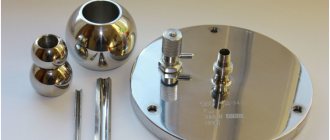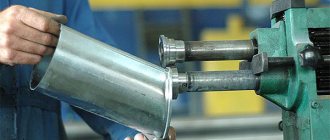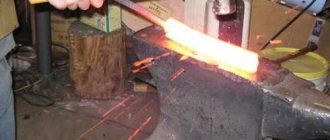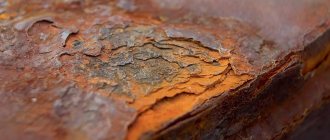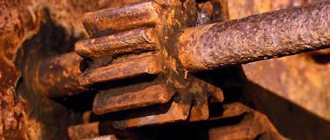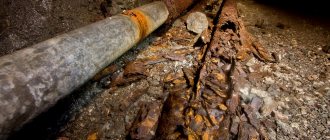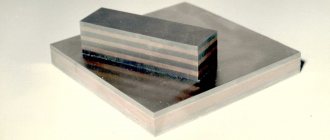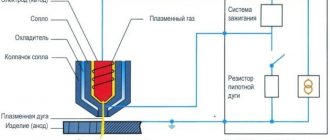Electrochemical corrosion refers to the most common processes of gradual destruction of metal.
As we know, our surroundings are filled with electricity.
Depending on the environment, conductivity indicators change. It is no different that upon contact with such an environment, steel gradually begins to deteriorate.
The process has several important differences.
First of all, the non-simultaneous occurrence of reduction of the oxidation process and ionization of metal atoms.
The intensity of propagation is influenced by such a parameter as the electrode potential of the metal.
The main reason for electrochemical corrosion is that most metals exhibit thermodynamic instability.
Examples of the spread of corrosion of this type are found in water, soil, and outdoors.
It often causes loss of strength and gradual destruction of metal on the bottom of ships, pipelines, power line supports and other objects.
If we talk about types of electrochemical corrosion , then there are 3 types:
- crevice lesions;
- pittings;
- intercrystalline damage.
Different types of metals can be damaged depending on their location. Rust appears upon contact with standing and flowing water, at the junction of different metals, as well as on welds.
What mechanisms are responsible for the occurrence of electrochemical corrosion?
Such metal damage is carried out by two mechanisms - homogeneous and heterogeneous. Let's look at each of them in detail.
- Homogeneous. Initially, the surface layer of the metal product is affected. Gradually, the metal begins to dissolve under the action of cathodic or anodic acts. Over a certain period of time, migration of the cathode and anode occurs. Over time, the process accelerates. The peculiarity of the homogeneous mechanism is that it affects both solid and liquid metals. Only the speed of the current changes.
- Heterogeneous. Most hard metals do not have a homogeneous surface. This is due to the fact that the composition of the crystal lattice in the material itself may differ. Just as in the case described above, anodic and cathodic processes are formed, and the metal begins to gradually deteriorate.
This type of process has several features.
First of all, there is a clear division into the cathodic and anodic process. One of the main factors influencing their rate of flow relative to each other is time.
Diagram of electrochemical corrosion
Depending on the type of metal, corrosion may be localized to specific areas. Dissolution of the surface layer on the anodes is also observed, which allows the lesion to affect large areas.
Here another feature of the process appears - the formation of galvanic cells. This occurs due to the specific structure of the surface on which microelectrodes are present.
Metal protective coating
The most interesting and promising is electrochemical protection against corrosion by another type of metal. Based on the nature of their protective effect, metallized coatings are divided into anodic and cathodic. Let's look at this point in more detail.
An anodic coating is a coating formed by a more active (less noble) metal than the one being protected. That is, protection is carried out with an element that is in the voltage range before the base material (for example, coating iron with zinc or cadmium). With local destruction of the protective layer, the less noble metal coating will corrode. In the area of scratches and cracks, a local galvanic cell is formed, the cathode of which is the metal being protected, and the anode is the coating, which is oxidized. The integrity of such a protective film does not matter. However, the thicker it is, the slower the electrochemical corrosion will develop, and the longer the beneficial effect will last.
Cathodic coating is a coating with a metal with a high potential, which in the series of voltages comes after the protected material (for example, spraying low-alloy steels with copper, tin, nickel, silver). The coating must be continuous, since when it is damaged, local galvanic cells are formed in which the base metal will be the anode and the protective layer will be the cathode.
What causes corrosion to develop?
After we have looked at the essence of electrochemical corrosion, it's time to pay attention to the reasons for the spread of corrosion .
Among them are three common ones:
- The alloy has a heterogeneous structure . In most alloys, the surface is inhomogeneous because foreign inclusions are present in the crystal lattice. The situation is also worsened by the presence of macro- and micro-type pores. This leads to the fact that corrosion products also begin to form unevenly.
- Inhomogeneous environment in which the metal is located . In order for corrosion to proceed faster, the access factor of the oxidizer is important. The electrochemical reaction can be accelerated.
- Difference in physical conditions . Corrosion intensifies if irradiation occurs and stray currents are present in the environment. Temperature also has a negative effect, especially with changes. In this case, the difference between cold and warm places causes the anode to appear.
It is precisely because of the difference in critical factors that the rate of electrochemical corrosion can vary greatly.
How to protect metal from oxidation
Electrochemical protection against corrosion is divided into two types: sacrificial and cathodic. The protective coating is similar to the anodic coating. A large plate of a more active alloy is attached to the material to be protected. A galvanic cell is formed, in which the base metal serves as the cathode, and the protector serves as the anode (it corrodes). Typically, zinc, aluminum or magnesium-based alloys are used for this type of protection. The protector gradually dissolves, so it must be replaced periodically.
Electrochemical corrosion of pipelines causes a lot of trouble in public utilities and in industry in general. In the fight against it, the cathodic polarization method is most suitable. To do this, a metal structure, which is protected from destructive oxidation processes, is connected to the negative pole of any external direct current source (it then becomes a cathode, and the rate of hydrogen evolution increases and the corrosion rate decreases), and a low-value metal is connected to the positive pole .
Electrochemical protection methods are effective in a conductive environment (a striking example is sea water). Therefore, protectors are often used to protect the underwater parts of marine vessels.
The main internal factors of electrochemical corrosion
The intensity of the spread of corrosion damage is influenced by two groups of factors - external and internal.
Current state of the metal surface
When the metal surface is uneven, the corrosion process is much more intense. If there are small protrusions on the surface, they begin to accumulate water.
This may negatively affect the rate of spread.
To prevent this factor, it is important to use ground or polished metal.
When the steel is smooth, water does not damage it as much because a uniform film gradually forms over the entire surface.
Also, a good way to reduce damage is the use of passivation, as well as a number of other methods.
The degree of thermodynamic resistance of the metal
Different types of materials differ in different indicators of thermodynamic stability.
The most resistant varieties of material do not collapse when placed in an aggressive environment.
To understand whether a metal has a tendency to corrosion under the influence of thermodynamic factors, the potential of the anodic and cathodic process, as well as the isobaric-isothermal process, is measured.
It is this factor that has a great influence on the potential impact of the environment on the gradual development of corrosion.
Unfortunately, most commercially available metal grades have low durability. There are also unstable varieties in which this risk is leveled due to the tendency to form passive films on the surface.
Crystallographic structure
Has a direct effect on the metal.
As you know, atoms in a crystal lattice are arranged differently. Those varieties whose atoms are loosely packed are better protected.
The characteristics of the lattice are also taken into account when planning the protection of the material by creating special films on it. Both the film and the base material itself must clearly match each other in composition or be as close as possible.
In this case, the appearance of stress, which negatively affects the current state of the workpiece, is eliminated. If contact with an aggressive environment does occur, the material begins to deteriorate layer by layer.
Heterogeneity
This factor is considered in direct connection with the grain size of the metal .
If there are pronounced anodic inclusions in the alloy, they greatly influence the acceleration of corrosion.
Cathode inclusions are not so dangerous because they do not affect the intensity of the process. Grain size as a risk factor is not considered so often and this indicator can be neglected.
Cathodic protection
The principle of cathodic protection can be implemented in one of two ways. The first is that the supply of negative potential can come from a special source of electricity called a cathodic protection station.
When using cathode stations, the following problem may arise.
Electricity to set the required potential is often supplied through a long cable. This cable is susceptible to lightning and certain other electromagnetic influences. To ensure that overvoltage does not occur as a result, it is recommended to use a comprehensive ZANDZ solution.
Mechanical factors should not be discounted either.
It is important to understand that many metal structures are used under constant voltage.
This category includes increased internal stress, when the risk of deformation greatly increases.
The quality of metal is also negatively affected by abrasion and periodic contact with other metal products.
This factor has a significant impact on the intensity of damage propagation.
Even if the raw material itself was initially resistant to potential damage, in this case it will decrease - the formed films simply will not attach to the surface.
Therefore, it is better to immediately eliminate this condition of electrochemical corrosion - try not to use metal structures under peak heavy loads, and prevent the occurrence of friction and contact of steel parts with each other.
Chemical corrosion
It usually occurs when the metal structure is exposed to dry gases, liquids or solutions that do not conduct electric current. The essence of this type of corrosion is the direct interaction of the metal with an aggressive environment. Elements chemically corrode during heat treatment or as a result of prolonged use at sufficiently high temperatures. This applies to gas turbine blades, smelting furnace fittings, internal combustion engine parts, and so on. As a result, certain compounds are formed on the surface: oxides, nitrides, sulfides.
Main external factors of electrochemical corrosion
In addition to internal factors, metal is also influenced by external factors .
They can not only speed up, but also slow down the process, and also influence the nature of its course.
These include the following:
- Temperature. Temperature greatly affects how metal behaves under different conditions. It greatly determines how quickly secondary corrosion products will dissolve. Other features include the launch and stimulation of diffusion processes in the metal, the creation of overvoltage on the electrodes and other manifestations. When a metal product is placed in solutions with oxygen depolarization, as the electrolyte warms up, the diffusion of the oxidizing agent accelerates. Against this background, a strong decrease in the oxygen ionization overvoltage is observed.
If a part is placed in solutions of non-oxidizing acids, corrosion with hydrogen depolarization occurs.
Increasing the temperature reduces the rate of damage propagation because the hydrogen overvoltage is greatly reduced.
Separately, it is worth noting the situation when the metal is already covered with a special protective film. In this case, the type of film itself will influence exactly how it will behave when in contact with various types of external threats, including increased temperature.
Heating and cooling can affect the condition of cathodes and anodes through their internal processes.
In some cases, the polarity of the electrodes changes significantly.
As we noted above, problems can arise due to the fact that different parts of the part are heated to different temperatures.
In this case, the number of thermogalvanic couples rapidly increases, stimulating the spread of corrosion to new areas.
- The pH level of the solution in which the metal is placed. An indicator such as pH indicates how active hydrogen ions will be in the solution, and how quickly corrosion will spread throughout the material. This is dangerous because it can unpredictably change the potential of cathodic processes and the formation of oxide films. It also creates a significant reaction overvoltage at the electrodes. It is recommended not to allow the metal to come into contact with media with a high pH.
If for some reason a metal workpiece is placed in a solution, the speed at which it moves, as well as the very presence of internal vibrations, will be of great importance.
Determining the exact effect in advance will be difficult for the reason that it is always difficult to predict how neutral electrolytes will behave.
It is believed that when the electrolyte is mixed, the diffusion of oxygen changes, which significantly affects the corrosion process.
You can pay less attention to the speed of movement of the electrolyte if you are dealing with highly acidic environments.
Such a defeat has minimal impact on them.
Treatment of aggressive environment
This method is effective when electrochemical corrosion of iron occurs in a small volume of conductive liquid. There are two ways to cope with destructive processes in this case:
- Removing oxygen from a liquid (deaeration) as a result of purging with an inert gas.
- By introducing inhibitors into the environment - so-called corrosion inhibitors. For example, if the surface is destroyed as a result of oxidation with oxygen, organic substances are added whose molecules contain certain amino acids (imino-, thio- and other groups). They are well adsorbed on the metal surface and significantly reduce the rate of electrochemical reactions leading to destruction of the surface contact layer.
What is the difference between anodic and cathodic processes?
If you carefully watch how a galvanic cell works, you will see that two interconnected processes take place in it at once - anode and cathode.
Let's look at them in more detail.
Anodic process
In chemistry it is shown by the formula Fe → Fe2+ + 2e. It shows that oxidation gradually starts, and metal ions begin to move into solution.
Cathode process
It can happen in different ways.
In particular, the excess of electrons is resolved by assimilation of the electrolyte and its molecules by atoms. Against this background, a reduction reaction occurs directly at the cathode itself.
The formula will depend on the conditions under which the reaction occurs.
So, in the presence of hydrogen depolarization, the process can be written as 2 H+ + 2e → H2.
It is important to understand that both processes are strongly related to each other under the influence of the kinetic factor.
Over time, a mutual slowdown or acceleration of the anodic or cathodic process may occur. In this case, the anode itself will always remain the place where metal corrosion forms.
When analyzing the progress of the corrosion process, attention is often paid to the electrically conductive phases and the moment after their contact.
Typically one phase has a positive charge while the other has a negative charge. This leads to the appearance of a potential difference.
In this way, a DEL appears, or as scientists often call it, a double electric layer with an asymmetric arrangement of particles in places where the phases separate.
A potential surge becomes dangerous for the metal. It can be stimulated by two central reasons:
- Greater stored hydration energy. In this case, metal ions are separated and gradually flow into the solution. As a result, a similar number of electrons remains on the surface, and the charge becomes negative. Further, in accordance with the laws of physics, the flow of cations from the solution is observed, and an EDL is formed at the boundary, as we have already described above.
- Discharge of electrolyte cations. As a result, the metal begins to rapidly take on a positive charge. DES appears due to the activity of solution anions in contact with electrolyte cations.
What happens if the surface layer of the metal has no definite charge at all ?
In this case, the DEL will not be observed, and the phenomenon of zero charge will occur.
Its potential will vary depending on what metal you are working with.
The described process significantly affects how corrosion proceeds and how quickly it captures more and more new areas of the metal.
In modern science there are no means that could accurately measure the magnitude of the potential jump, which means that the process of formation of the electromotive force is not so intense.
If we consider issues related to the process of polarization, we can write a separate article on this topic.
Therefore, next we will consider another important indicator - polarization .
Process description
Electrochemical corrosion is a process that occurs in the presence of:
- electrolyte;
- metals with low and high redox potentials (electrode potentials).
The electrolyte is formed by water, condensate, and any natural precipitation. The presence of two types of metal almost always does not happen, and is due to two factors:
- Heterogeneity of the product, that is, the presence of foreign inclusions.
- Direct contact with products made of various metals.
In an electrolyte, inhomogeneous metals form a short-circuited galvanic cell called a corrosion cell. This combination leads to the dissolution of metal with a lower electrode potential, which is called electrochemical corrosion. The speed of this process strongly depends on the presence of salts in the solution and its temperature.
Polarization and its effect on the rate of corrosion
The polarization process is associated with the intensity of the spread of electrochemical corrosion.
This indicator reflects how strong the overvoltage is in a certain area.
It is customary to distinguish three types of polarization:
- Electrochemical. Most often observed in a situation where the cathodic and anodic processes begin to slow down.
- Phase. Occurs when a new phase forms on the surface of the material.
- Concentration. This process appears if there are very low rates of removal of corrosion products, as well as the approach of the depolarizer.
The features of polarization should also be taken into account if you are interested in additional protection of metals from gradual destruction.
Main objects of corrosion
Inhomogeneous metal areas are randomly located on the surface of the product and depend on the technology and quality of their manufacture, so corrosion damage is often local in nature. In addition, the locality of corrosion depends on heterogeneity:
- protective oxide films;
- electrolyte;
- influence of external factors (heating, irradiation);
- internal stresses causing uneven deformation.
Welded and riveted joints are prominent representatives of the contact of foreign metals subject to active electrochemical corrosion. Welding and riveting are the most common technologies in the construction of permanent joints in all leading industries and large pipeline systems:
- mechanical engineering;
- shipbuilding;
- oil pipelines;
- gas pipelines;
- water pipes.
The most significant damage to welds and rivet joints occurs in sea water, the presence of salt in which significantly accelerates the corrosion process.
A catastrophic situation arose in 1967 with the ore carrier Anatina , when sea water from high storm waves entered the ship’s holds. Copper structures in the interior of the holds and the steel hull contributed to the creation of a corrosive element in the seawater electrolyte. Transient electrochemical corrosion caused softening of the ship's hull and the creation of an emergency situation, leading to the evacuation of the crew.
The positive effect of electrochemical corrosion is very rare. For example, when installing new pipes in hot heating systems of residential buildings. The threaded connections of the couplings begin to flow during the initial start-up until corrosion products consisting of hydrated iron fill the micropores in the threads.
Regardless of the type of corrosion, chemical or electrochemical, its consequences are the same - the destruction of products of enormous value . Moreover, in addition to direct losses from materials that have become unusable, there are indirect losses associated with product leaks, downtime when replacing unusable materials and parts, and violations of technological process regulations.
Types of corrosion processes
Metal corrosion comes in many varieties. But basically all types are divided into two main types:
- General corrosion. It is called uniform, and it occurs most often. The cause of such corrosion is considered to be chemical and electrochemical reactions. This type of corrosion leads to a negative impact on the entire surface of the material and metal structure. In this case, the process can be uniform or uneven. When rust is unevenly distributed, it corrodes the material in one area faster and more strongly than in the neighboring one.
- Local type of corrosion. It occurs in one area, where it develops.
- Local stains. Occurs in individual areas of the material.
- Ulcerative, also called pitting.
- Intercrystalline - this type of corrosion occurs at the boundary regions of a metal crystal. It flares up more often in materials that contain nickel and aluminum. The metal in the shortest possible time remains without its original strength and elasticity indicators.
- Cracking.
- Subsurface.
- Corrosion under current - occurs under the influence of stray or direct current.
- Corrosive cavitation is a type of destruction when, in addition to rust, the metal is also affected by an impact force.
- Fretting corrosion is the simultaneous effect of rust and vibration, which together lead to the destruction of metal structures. options.
There are also differences in the mechanism of action.
See also: The most expensive metals in the world
Chemical destruction option
This is a type of process in which metallic bonds are destroyed, and a chemical interaction occurs between the atoms of the material substances and oxidizing agents. In such a situation, no electrical current is generated between different areas of the material. In turn, this type of destruction is divided into two more types:
- Gas option. It is obtained when exposed to aggressive elements, as well as vapors in combination with high temperatures. If the material is active, then exposure to such environments can lead to the final destruction of the material over the entire surface. Such media include: hydrogen sulfide, sulfur dioxide, water vapor, oxygen. This type of destructive process is most often noticeable in industry and chemical production.
- Liquid version of rust. Occurs in non-electrolytic substances. If there is even a small liquid content, the process becomes electrochemical.
It is important that with the chemical type of corrosion, the metal is destroyed at the rate of the chemical reaction.
See also: Metal forming
Electrochemical rust
This variant of destructive processes occurs in an electrolyte environment. The process is combined with the generation of current. As a result, an atom is removed from the lattice of the substance and two processes occur simultaneously:
- Anodic - the substance of the material enters the solution as ions.
- Cathodic - those substances that are obtained in the previous process are bonded using a depolarizer.
The actual removal of the electrodes is called depolarization, and the substances that contribute to this process are called depolarizers.
Most often it is possible to encounter a variant of destruction with hydrogen and oxygen depolarization.
